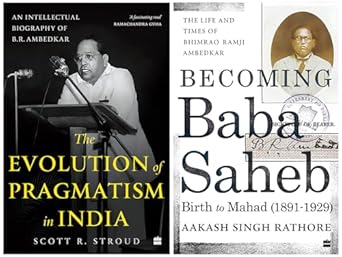Book Review: Becoming Babasaheb: The Life by Aakash Singh Rathore
Dr. B.R. Ambedkar remains one of the most towering figures in modern Indian history—a revolutionary thinker, political visionary, and social reformer whose legacy continues to shape contemporary India. In Becoming Babasaheb: The Life, author and philosopher Aakash Singh Rathore offers a powerful and engaging narrative of Ambedkar’s early life, tracing his evolution from Bhimrao of Mhow to the fierce reformist who would later be known as Babasaheb.
This first volume in Rathore’s biographical series spans the years 1891 to 1929, capturing not only the key moments of Ambedkar’s life during this period but also the historical, political, and cultural context in which he operated. What makes this work stand out is its combination of rigorous scholarship and narrative accessibility. Rathore writes with the sensibility of a philosopher and the sensitivity of a storyteller, ensuring that the book appeals both to academic readers and the general public.
An Intimate Portrait of a Revolutionary Mind
One of the most commendable aspects of Becoming Babasaheb is its attention to the inner world of Ambedkar. Rathore goes beyond dates and events to explore the emotional, intellectual, and psychological dimensions of Ambedkar’s growth. Whether it’s his early experiences of caste-based discrimination, his academic pursuits in New York and London, or his encounters with radical political ideas, the book gives readers a close-up view of how a young boy from a marginalized community emerged as one of India’s most profound thinkers.
The book is particularly effective in documenting Ambedkar’s education abroad. Rather than treating these years as a mere interlude, Rathore positions them as formative and transformative. At Columbia University, Ambedkar was not just a student; he was absorbing a world of ideas—liberalism, pragmatism, political economy, and democratic theory. Rathore carefully connects these intellectual engagements to Ambedkar’s later writings and activism, showing how deeply influenced he was by the likes of John Dewey and how he molded Western ideas to fit the Indian context.
Historical Context Meets Personal Struggle
While the book is a biography, it also reads like a social history of colonial India. Rathore does not isolate Ambedkar from the broader currents of his time. Instead, he weaves in the dynamics of British imperialism, the early nationalist movement, and the rise of caste politics. In doing so, the book reminds readers that Ambedkar was not only resisting upper-caste oppression but also challenging the terms of nationalism and questioning the moral foundations of the Indian freedom struggle itself.
A particularly strong chapter is the one on the Mahad Satyagraha (1927), where Ambedkar led Dalits to drink from the Chavdar tank, a public water source from which they were traditionally barred. Rathore recounts the event not just as an act of civil disobedience, but as a turning point in Ambedkar’s public life. It was at Mahad that Ambedkar, as the title suggests, became Babasaheb—a leader with moral authority, mass support, and an unyielding commitment to justice.
Balanced, Yet Bold
What distinguishes Rathore’s work from other biographies is his balanced but bold approach. He doesn’t mythologize Ambedkar, nor does he downplay the contradictions in his life. For example, Rathore explores Ambedkar’s complex relationship with the Indian National Congress and Mahatma Gandhi, offering a nuanced view of their ideological clashes. He also discusses how Ambedkar’s early economic writings—often overlooked—were deeply radical and prescient in their critique of capitalism and landlessness.
Moreover, Rathore’s background as a philosopher allows him to engage with Ambedkar’s ideas on a deeper level. The book is rich in analytical commentary, yet it never loses sight of its narrative drive. Rathore strikes a careful balance between telling a story and offering interpretation, making it both informative and thought-provoking.
Accessible and Engaging
The language of Becoming Babasaheb is lucid and engaging, which is commendable given the complexity of its subject. Rathore’s prose is reflective but never pretentious. He avoids jargon and instead lets the power of Ambedkar’s ideas and the drama of his life speak for themselves. The inclusion of letters, anecdotes, and lesser-known facts adds a layer of richness to the biography.
The book is also well-researched, drawing on a wide range of sources including Ambedkar’s writings, government records, and secondary literature. Rathore is meticulous in his documentation, yet he never allows the research to bog down the narrative. Instead, the scholarship serves the storytelling, reinforcing the credibility of the account.
Conclusion
Becoming Babasaheb: The Life is a monumental and timely contribution to the literature on Dr. B.R. Ambedkar. As India continues to grapple with issues of caste, inequality, and democracy, Rathore’s work offers both historical insight and moral clarity. This is not just a biography—it is a call to remember, to reflect, and to act. On the occasion of Ambedkar Jayanti, this book stands as a fitting tribute to a man who reshaped the Indian imagination and redefined what it means to fight for justice.




